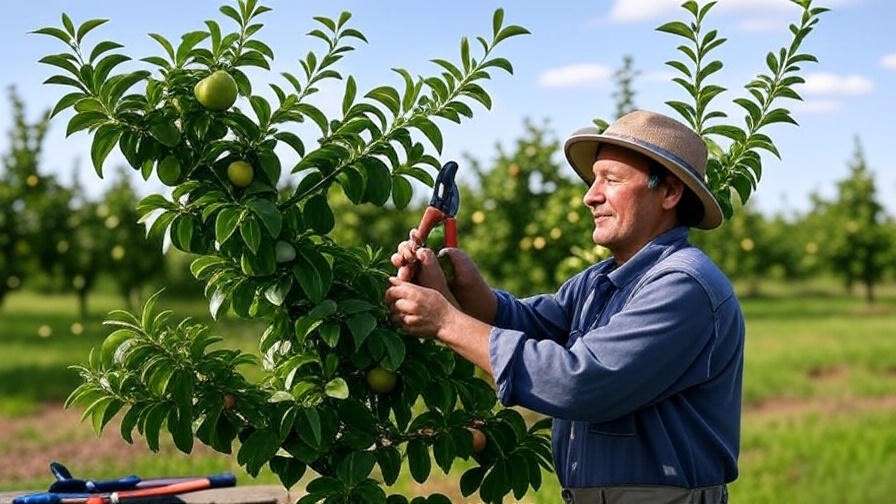Picture this: your backyard orchard bursting with plump, juicy apples, peaches, and cherries, each fruit more vibrant than the last, with trees that thrive year after year. 🌱 The secret? Knowing how to prune a fruit tree properly. Pruning isn’t just a chore—it’s an art and science that boosts fruit production, strengthens tree structure, and prevents disease. Whether you’re a novice gardener or a seasoned orchardist, this guide will empower you to prune with confidence. Backed by decades of horticultural expertise and trusted sources like university extension programs, we’ll walk you through every step, from timing to tools, ensuring your fruit trees flourish. 🍏
In this comprehensive 2000+ word guide, you’ll learn the why, when, and how of pruning fruit trees, with practical tips, species-specific advice, and expert insights to maximize yield and tree health. Let’s dig in! 🌿
Why Pruning Fruit Trees Is Essential 🌿
Pruning is the cornerstone of fruit tree care, and its benefits go far beyond aesthetics. By selectively removing branches, you shape the tree’s growth, improve its health, and increase fruit quality. Let’s explore why pruning is non-negotiable for a thriving orchard.
The Science Behind Pruning
Pruning stimulates healthy growth by directing the tree’s energy to productive areas. Removing overcrowded or dead branches improves air circulation, reducing the risk of fungal diseases like powdery mildew. It also allows sunlight to penetrate the canopy, which is critical for fruit ripening and flavor development. According to the University of California’s Agriculture and Natural Resources program, proper pruning can increase fruit yield by up to 30% in some varieties. 🍑
Benefits for Your Fruit Trees
- Increased Fruit Yield and Quality: Pruning encourages the growth of fruiting spurs, leading to larger, tastier harvests.
- Stronger Tree Structure: Removing weak or crossing branches prevents breakage under heavy fruit loads.
- Disease Prevention: Improved airflow and sunlight exposure reduce the risk of pests and diseases.
- Longevity: Regular pruning extends a tree’s productive lifespan, sometimes by decades.
- Aesthetic Appeal: A well-pruned tree enhances the beauty of your garden or orchard.
When to Prune Fruit Trees: Timing Is Everything ⏰
Timing your pruning correctly is critical to avoid stressing your tree or reducing its yield. The best time depends on the season, tree type, and your climate.
Seasonal Pruning Guide
- Winter (Dormant Season): Late winter, before buds swell, is the ideal time for most fruit trees. Dormant pruning promotes vigorous spring growth and allows you to see the tree’s structure clearly. It’s perfect for apples, pears, and most deciduous trees.
- Summer Pruning: Light pruning in summer controls excessive growth, shapes young trees, and removes water sprouts. It’s also useful for stone fruits like peaches to reduce disease risk.
- Exceptions: Some trees, like apricots, are prone to bacterial canker and should be pruned in early summer to minimize infection risk.
Regional and Climate Considerations
Your pruning schedule should align with your local climate. In colder regions (USDA zones 4–6), wait until the risk of hard frost passes in late winter. In warmer climates (zones 8–10), you may prune earlier in winter or even late fall. For tropical regions, focus on dry seasons to avoid fungal issues. Check your local frost dates or consult your cooperative extension service for precise timing. 🌞
Tools You’ll Need for Pruning 🛠️
Having the right tools makes pruning easier, safer, and more effective. Investing in quality equipment ensures clean cuts and reduces the risk of tree damage.
Essential Pruning Equipment
- Hand Pruners: Ideal for small branches (up to ¾ inch thick). Choose bypass pruners for clean cuts.
- Loppers: For branches up to 2 inches in diameter, long-handled loppers provide extra leverage.
- Pruning Saw: For thicker branches, a folding or curved saw works best.
- Safety Gear: Wear gloves, safety goggles, and sturdy shoes to protect yourself.
- Sterilizing Solution: Use rubbing alcohol or a 10% bleach solution to clean tools between cuts.
Choosing High-Quality Tools
Opt for trusted brands like Felco or Fiskars for durability and precision. For example, Felco F-2 pruners are a favorite among arborists for their ergonomic design and sharp blades. Expert Tip: Sterilize tools between trees with a quick wipe of alcohol to prevent spreading diseases like fire blight. 🧼 Always store tools clean and dry to maintain their edge.
Step-by-Step Guide to Pruning a Fruit Tree 🌳
Pruning may seem daunting, but with a clear plan, it’s straightforward. Follow these steps to prune like a pro.
Step 1: Assess Your Tree
Start by examining your tree’s overall health and structure. Look for:
- Dead, Damaged, or Diseased Branches (the 3 Ds): These should be removed first to prevent further issues.
- Crossing or Rubbing Branches: These can create wounds that invite pests or disease.
- Suckers and Water Sprouts: Vigorous, upright shoots that sap energy from fruit production.
Use a ladder for taller trees, but ensure it’s stable to avoid injury. Take note of the tree’s natural shape and growth patterns to guide your cuts.

Step 2: Plan Your Cuts
Before cutting, decide your pruning goals:
- Young Trees: Focus on shaping for a strong framework (e.g., central leader or open center system).
- Mature Trees: Maintain structure, remove excess growth, and encourage fruiting wood.
- Neglected Trees: Plan gradual rejuvenation over several seasons to avoid shock.
Understand your tree’s growth habit. For example, apple trees thrive with a central leader (a single main trunk), while peaches benefit from an open center (vase-like shape) for better airflow.
Step 3: Make Precise Cuts
Use the right technique to avoid damaging your tree:
- Thinning Cuts: Remove entire branches at their base to improve light and air penetration.
- Heading Cuts: Shorten branches to encourage branching or control height.
- Cut Angles: Make cuts at a 45-degree angle, ¼ inch above a bud or branch collar, to promote healing.
Common Mistake: Avoid “stub cuts” (leaving too much branch) or flush cuts (cutting too close to the trunk), as both can harm the tree.
Step 4: Shape for Success
- Young Trees: Establish a strong framework by selecting 3–5 scaffold branches (main branches) spaced evenly around the trunk. Remove competing branches to prevent crowding.
- Mature Trees: Thin out 10–20% of the canopy annually to maintain light penetration. Focus on removing vertical shoots and keeping the canopy balanced.
Visual Example: A diagram showing a 45-degree cut above a bud would be ideal here to illustrate proper technique. 📏
Step 5: Clean Up and Care
- Dispose of pruned branches away from the orchard to prevent pest or disease spread.
- Apply a thin layer of mulch around the tree’s base (but not touching the trunk) to retain moisture.
- Monitor the tree for signs of stress or infection in the weeks following pruning.
Pruning Different Types of Fruit Trees 🍏🍒
Not all fruit trees are pruned the same way. Each type has unique needs based on its growth habits, fruiting patterns, and disease susceptibility. Below, we’ll cover tailored pruning strategies for common fruit trees to ensure optimal health and yield.
Apple and Pear Trees
Apple and pear trees (pome fruits) are among the most common backyard fruit trees, and they thrive with a central leader system—a single main trunk with evenly spaced lateral branches.
- Pruning Goals: Encourage fruiting spurs (short, stubby branches that produce fruit) and maintain an open canopy for sunlight.
- Technique: In late winter, remove vertical water sprouts and thin out crowded areas. Keep scaffold branches at a 45–60-degree angle from the trunk for strength. For mature trees, cut back 10–15% of older wood annually to stimulate new growth.
- Expert Tip: Avoid over-pruning apple trees, as this can lead to excessive vegetative growth at the expense of fruit. Aim for balance, as advised by the Royal Horticultural Society. 🍎
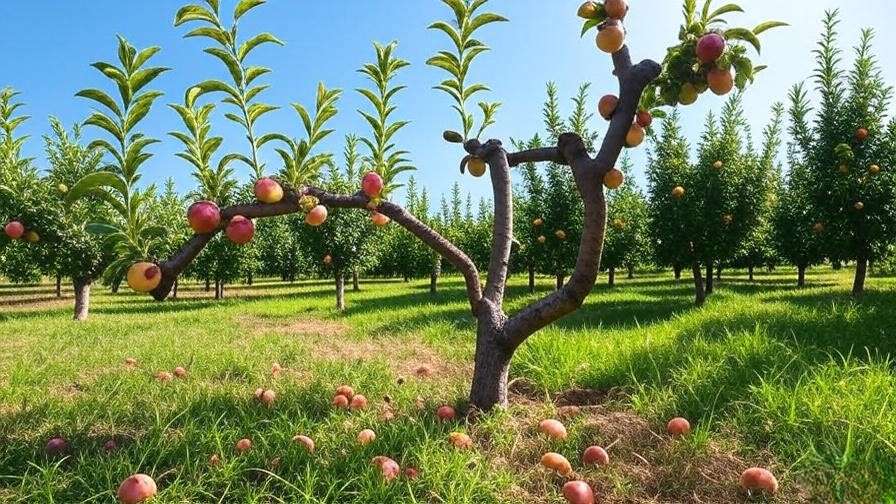
Stone Fruit Trees (Peaches, Plums, Cherries)
Stone fruit trees, such as peaches, plums, and cherries, require an open center (vase-shaped) structure to maximize airflow and reduce disease risk, especially for fungal issues like peach leaf curl.
- Pruning Goals: Promote wide branch angles and remove inward-growing branches to keep the center open.
- Technique: Prune in early summer for peaches and apricots to minimize bacterial canker. Thin out 20–30% of the canopy to allow light to reach ripening fruit. For cherries, focus on removing suckers and maintaining a balanced shape.
- Special Consideration: Peaches fruit on one-year-old wood, so annual pruning is critical to renew fruiting branches. 🍑
Citrus Trees
Citrus trees, like oranges, lemons, and limes, need lighter pruning than deciduous trees due to their evergreen nature and sensitivity to cold.
- Pruning Goals: Maintain shape, remove dead wood, and improve airflow to prevent pests like citrus leaf miners.
- Technique: Prune in late spring or early summer after the last frost. Remove suckers below the graft union and thin out dense areas. Avoid heavy pruning, as citrus trees recover slowly.
- Frost Damage Tip: In colder climates (e.g., USDA zone 8), wait until summer to prune frost-damaged branches to assess the extent of injury. 🍊
Other Fruit Trees (Figs, Persimmons, etc.)
Less common fruit trees like figs and persimmons have unique pruning needs that vary by climate and variety.
- Figs: Prune minimally to maintain an open structure. In colder regions, cut back to protect against winter damage. Figs fruit on new and old wood, so balance pruning to preserve fruiting potential.
- Persimmons: Use a modified central leader system and prune lightly to avoid stressing the tree. Remove crowded branches to improve light exposure.
- Expert Insight: According to the University of Georgia Extension, figs benefit from light annual pruning to encourage vigorous new growth for larger harvests. 🌿
Common Pruning Mistakes and How to Avoid Them 🚫
Even experienced gardeners can make pruning errors that harm fruit trees. Here are common pitfalls and how to sidestep them:
- Over-Pruning: Removing too much canopy (more than 25–30% in one season) can stress the tree and reduce fruit yield. Solution: Prune conservatively, especially for young or struggling trees.
- Incorrect Cut Angles: Cutting too close to the trunk (flush cuts) or leaving stubs can invite disease. Solution: Cut at a 45-degree angle just above the branch collar, as shown in pruning guides from Cornell University.
- Ignoring Tree Age or Species: Using the same approach for all trees can lead to poor results. Solution: Research your tree’s specific needs (e.g., peaches vs. apples).
- Pruning at the Wrong Time: Pruning during active growth or bloom can weaken the tree. Solution: Stick to recommended seasonal schedules.
- FAQ: Can I prune my fruit tree too much? Yes, over-pruning can lead to excessive vegetative growth or shock. Limit cuts to 20–25% of the canopy per year and monitor the tree’s response.
Advanced Pruning Techniques for Expert Gardeners 🌟
For those ready to take their pruning skills to the next level, these advanced techniques can enhance tree performance and aesthetics.
Rejuvenating Old or Neglected Trees
Reviving an overgrown or neglected fruit tree requires patience and a multi-year plan to avoid shocking the tree.
- Step-by-Step Process:
- Year 1: Remove dead, diseased, and crossing branches. Thin out 10–15% of the canopy to improve light penetration.
- Year 2: Focus on shaping by selecting strong scaffold branches and removing competing growth.
- Year 3: Continue thinning and encourage new fruiting wood with heading cuts.
- Case Study: A 20-year-old apple tree in a community orchard was rejuvenated over three seasons, resulting in a 40% increase in fruit yield, as documented by a local cooperative extension.
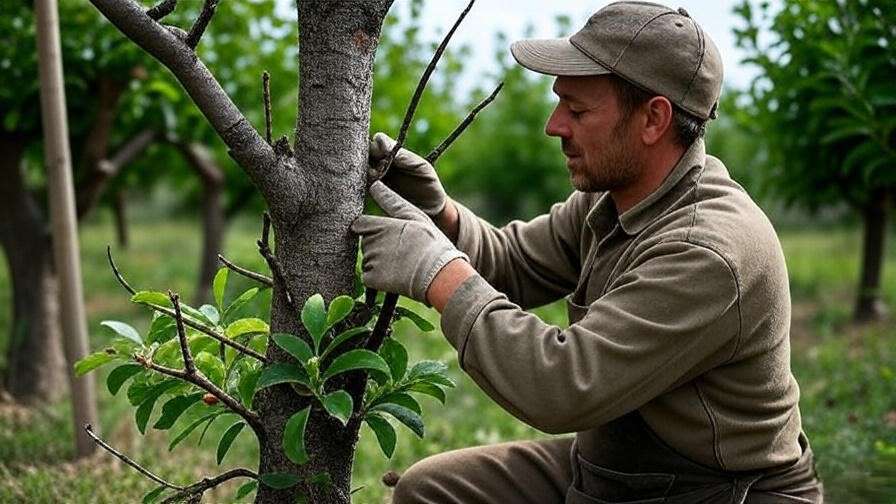
Espalier and Training Techniques
Espalier is a space-saving technique that trains trees to grow flat against a wall or trellis, ideal for small gardens or decorative purposes.
- Best Trees: Apples and pears are ideal due to their flexible branches.
- Technique: Select 2–4 horizontal branches and tie them to a support structure. Prune vertical shoots and maintain the desired shape annually.
- Benefit: Espalier maximizes fruit production in limited spaces while adding visual appeal.
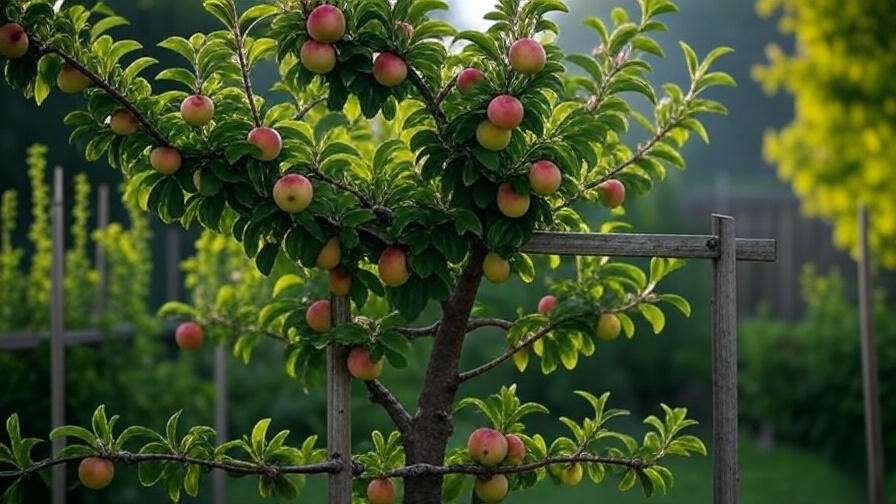
Grafting and Pruning Synergy
Pruning supports successful grafting, which allows you to grow multiple fruit varieties on one tree.
- Technique: After grafting, prune to direct energy to the new graft. Remove competing branches below the graft site to ensure its dominance.
- Expert Tip: According to the American Horticultural Society, precise pruning post-grafting can improve graft success rates by up to 80%.
Post-Pruning Care for Optimal Recovery 🌞
Proper care after pruning helps your tree recover quickly and thrive.
- Watering: Provide deep watering immediately after pruning to reduce stress, especially in dry climates. Aim for 1–2 inches of water per week, depending on soil type.
- Fertilizing: Apply a balanced fertilizer (e.g., 10-10-10) in early spring to support new growth. Avoid over-fertilizing, which can lead to excessive foliage at the expense of fruit.
- Mulching: Add a 2–4-inch layer of organic mulch (e.g., wood chips or compost) around the tree’s base, keeping it 2 inches from the trunk to prevent rot.
- Monitoring: Check for signs of stress (e.g., wilting leaves) or pests in the weeks following pruning. Treat issues promptly with organic or chemical controls as needed.
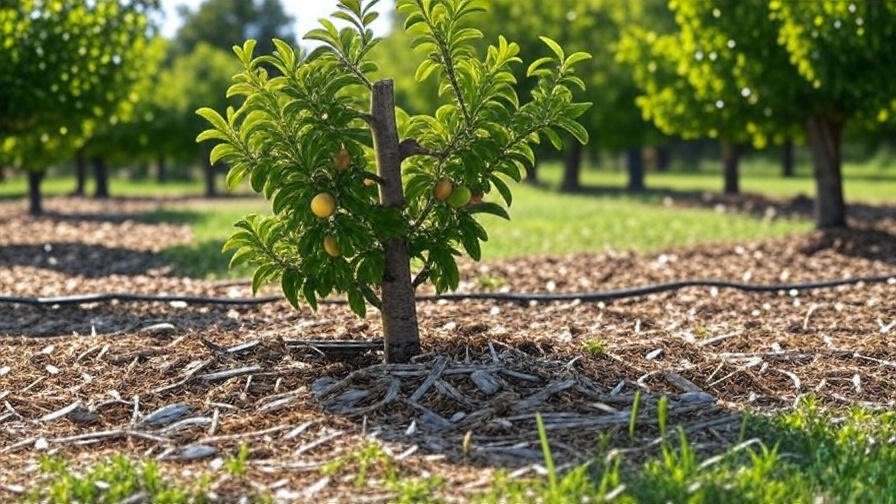
FAQs: Your Fruit Tree Pruning Questions Answered ❓
- When is it too late to prune my fruit tree? Late spring or summer pruning can stress trees during active growth. Stick to late winter for most trees, unless you’re managing specific issues like water sprouts.
- How do I know if I’m pruning too much? If you remove more than 25% of the canopy or notice excessive new shoots, you may be over-pruning. Scale back and observe the tree’s response.
- Can I prune a fruit tree in bloom? Avoid pruning during bloom, as it can reduce fruit set. Wait until after flowering for light maintenance cuts.
- Source: These answers align with recommendations from the Royal Horticultural Society and USDA extension services.
Conclusion: Prune Your Way to a Thriving Orchard! 🍊
Pruning your fruit trees is a rewarding investment in their health, beauty, and productivity. By following this guide, you’ve learned how to prune a fruit tree with precision, from choosing the right tools to mastering species-specific techniques. Whether you’re shaping a young apple tree or reviving an old peach, these expert-backed strategies will help you achieve bountiful harvests and a stunning orchard. Start small, prune with care, and watch your trees thrive! 🌳
Call to Action: Try these pruning techniques this season and share your success stories in the comments. For more tree care tips, check out our guides on soil health and pest control. Happy pruning! 🌱

